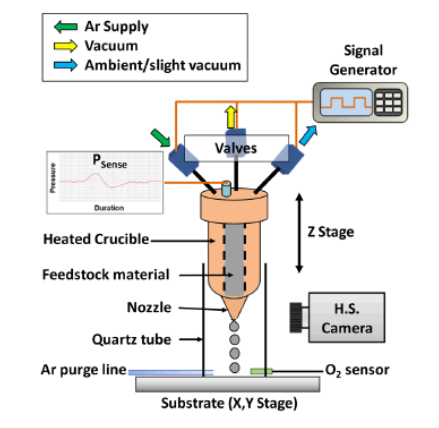For metal additive manufacturing, Drop-on-Demand Liquid Metal Jetting (DOD-LMJ) is a less expensive alternative to Laser Powder Bed Fusion (L-PBF). In DOD-LMJ, a momentum pulse pushes out discrete droplets of molten metal through the nozzle in a controlled stream that then rapidly cools and solidifies upon impact; metal structures of arbitrary shape can then be fabricated. The challenge of DOD-LMJ is the method should produce a constant jet of uniform, single droplets of the molten material at a much faster flow rate than conventional LMJ.
LLNL’s approach to meet this challenge is to use a pneumatic DOD-LMJ method wherein the nozzle is filled with a molten pure metal or metal alloy. There are two reservoirs in LLNL’s invention that are in direct contact with each other: the liquid metal reservoir that is constantly heated so the metal remains molten and an inert gas reservoir, which is connected to an inert gas pressure source. An electronically controlled valve controls the rate of gas flow in and out of the gas reservoir. By rapidly opening and closing this valve, a sequence of rapid inflows of inert gas into a gas reservoir displaces liquid volume and causes the dense liquid within the nozzle to pressurize and molten material to protrude from the nozzle. The pressure valve is then quickly shut off, while a second valve opens to release the pressurized gas to the atmosphere. This allows any ejected liquid material to naturally retract back into the nozzle, while a disconnected droplet is allowed to escape from the nozzle, traveling by its own momentum towards the substrate.
Image Caption: Pneumatic DOD-LMJ printhead with supporting setup
Nicholas N. Watkins, Eric S. Elton, Phillip H. Paul, Victor A. Beck, Jason R. Jeffries, Andrew J. Pascall; Experimentally probing the extremes of droplet-on-demand printability via liquid metals. Physics of Fluids 1 December 2021; 33 (12): 121708 (https://doi.org/10.1063/5.0076594).
Idell, Y., Watkins, N., Pascall, A. et al. Microstructural Characterization of Pure Tin Produced by the Drop-on-Demand Technique of Liquid Metal Jetting. Metall Mater Trans A 50, 4000–4005 (2019) (https://doi.org/10.1007/s11661-019-05357-z).
- Value Proposition: Improved control over droplet ejection in pneumatic Drop-on-Demand (DOD) 3D printers
- Faster pressure response provides better timing control of droplet formation
- Droplets are formed closer to the nozzle, which reduces meniscus oscillations and allows for a higher max ejection frequency
- Drop-on-Demand Additive Manufacturing
- Liquid metal printing
- Microcasting
Current stage of technology development: TRL 3
LLNL has filed for patent protection on this invention.


